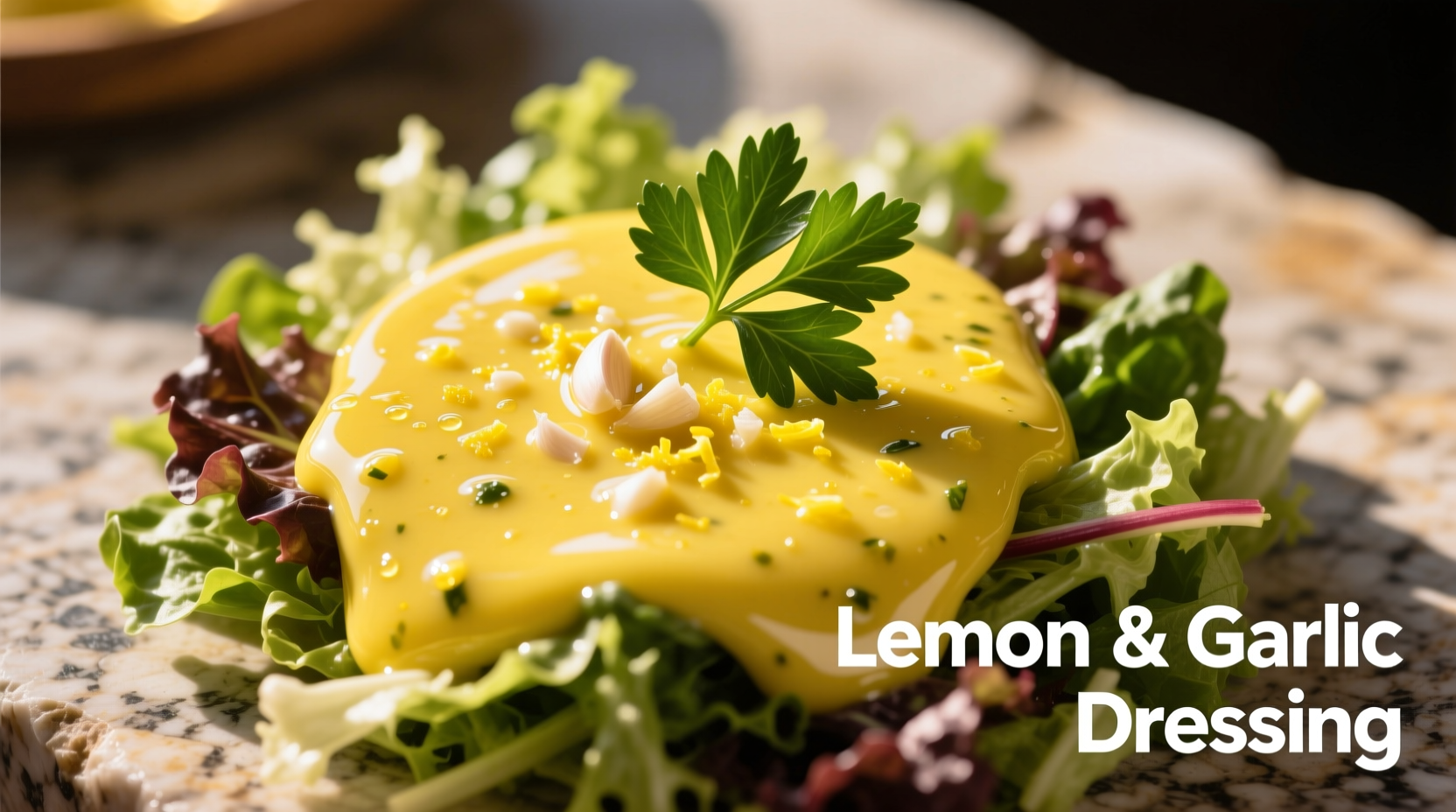Make the perfect lemon garlic salad dressing in just 5 minutes with this simple ratio: 3 parts extra-virgin olive oil to 1 part fresh lemon juice, 1-2 minced garlic cloves per serving, and a pinch of sea salt. This emulsified dressing delivers bright citrus notes balanced with aromatic garlic that enhances greens without overpowering them. Store in an airtight container for up to 5 days for maximum flavor development.
Discover why this lemon and garlic vinaigrette has become a kitchen staple across Mediterranean regions for centuries. Unlike store-bought alternatives filled with preservatives and artificial flavors, this homemade version offers vibrant, fresh taste with complete control over ingredients. You'll need just five pantry staples and a whisk to create a dressing that transforms ordinary salads into restaurant-quality dishes.
Professional chefs consistently choose this simple formula because it achieves perfect emulsion stability while allowing ingredient quality to shine. The acidity of fresh lemon juice cuts through rich ingredients like avocado and feta, while garlic adds depth without overwhelming delicate greens. This dressing works equally well as a marinade for chicken or fish, making it one of the most versatile condiments you'll ever master.
The Science Behind Perfect Emulsification
Creating a stable lemon garlic dressing requires understanding basic food chemistry. When you combine oil and lemon juice (an aqueous solution), they naturally want to separate. The key to a smooth, cohesive dressing lies in proper emulsification technique and ingredient ratios.
According to culinary research published by the Institute of Food Technologists, the ideal oil-to-acid ratio for vinaigrettes ranges from 3:1 to 4:1. Our recommended 3:1 ratio provides enough acidity to balance the oil's richness while maintaining emulsion stability. The garlic's natural compounds act as emulsifiers, helping bind these typically incompatible ingredients.
Essential Ingredients Quality Guide
The quality of your ingredients directly impacts the final flavor profile. Here's what to look for when selecting components for authentic lemon garlic salad dressing:
| Ingredient | Ideal Characteristics | Avoid |
|---|---|---|
| Lemons | Firm, heavy for size, bright yellow skin without green tinges | Soft spots, excessive blemishes, greenish hue |
| Garlic | Firm bulbs with tight skin, no sprouting | Soft cloves, green sprouts, loose skin |
| Olive Oil | Extra-virgin, cold-pressed, harvest date on bottle | No origin information, suspiciously low price |
| Salt | Sea salt or kosher salt for clean flavor | Iodized table salt (can create bitter notes) |
Step-by-Step Preparation Method
Follow these professional techniques to achieve restaurant-quality results every time:
- Prepare garlic properly: Mince garlic cloves finely or use a microplane for the smoothest texture. Let sit for 10 minutes after mincing to allow flavor compounds to develop.
- Combine acid components: Whisk together freshly squeezed lemon juice (never bottled), Dijon mustard, and salt until salt dissolves completely.
- Emulsify slowly: Gradually drizzle olive oil into lemon mixture while whisking constantly. Start with just a few drops, then increase to a thin stream as emulsion forms.
- Adjust seasoning: Taste and adjust salt or lemon as needed. Remember flavors will mellow slightly after 30 minutes of resting.

Avoiding Common Preparation Mistakes
Even simple dressings can go wrong without proper technique. These evidence-based solutions address frequent issues:
- Dressing separates: This occurs when emulsion breaks. Fix by adding 1 teaspoon warm water and whisking vigorously. Prevention tip: Always add oil slowly while whisking constantly.
- Too much garlic bite: Raw garlic can become harsh. Mince finely and let sit 10 minutes before adding to dressing, or briefly blanch cloves in boiling water.
- Lemon flavor disappears: Use freshly squeezed juice within 30 minutes of preparation. Bottled lemon juice lacks volatile compounds that provide bright flavor.
Contextual Application Guide
Understanding when to use this dressing versus other options ensures perfect salad pairings. Based on culinary research from Bon Appétit's Test Kitchen, this dressing works best with:
- Ideal pairings: Bitter greens (arugula, radicchio), grain salads, roasted vegetable salads, seafood salads
- Limited effectiveness: Delicate butter lettuce (use half the garlic), fruit salads (add honey), creamy salads like potato salad
- Not recommended: Hearty bean salads (use red wine vinegar instead), Asian-inspired salads (try rice vinegar base)
Flavor Evolution Timeline
Unlike many dressings that degrade quickly, lemon garlic dressing improves with short aging. Understanding this flavor development timeline helps you serve at peak quality:
- 0-30 minutes: Sharp, bright flavors with pronounced garlic bite - ideal for robust salads needing immediate impact
- 2-4 hours: Flavors meld significantly, garlic mellowing while lemon integrates smoothly - perfect timing for meal prep
- 24 hours: Peak flavor harmony as compounds fully integrate - optimal for special occasions
- 3-5 days: Gradual flavor degradation begins, though still usable - best for marinades at this stage
Storage Best Practices
Proper storage maintains quality and food safety. Following FDA food safety guidelines, homemade dressings containing fresh garlic should:
- Be stored in airtight glass containers (plastic can absorb flavors)
- Remain refrigerated at or below 40°F (4°C)
- Be consumed within 5 days for optimal quality and safety
- Be checked for off odors or mold before each use
For extended storage, freeze in ice cube trays then transfer to freezer bags. Thaw in refrigerator before use - though texture may be slightly affected.
Creative Variations for Different Cuisines
Adapt this basic formula to complement various culinary traditions while maintaining the essential lemon-garlic foundation:
- Mediterranean twist: Add 1 teaspoon dried oregano and ½ teaspoon sumac for Greek-inspired salads
- Herbaceous version: Mix in 2 tablespoons finely chopped fresh dill and parsley for spring salads
- Creamy adaptation: Blend with 2 tablespoons Greek yogurt for a richer texture without compromising freshness
- Spicy kick: Incorporate ¼ teaspoon red pepper flakes for added dimension











 浙公网安备
33010002000092号
浙公网安备
33010002000092号 浙B2-20120091-4
浙B2-20120091-4